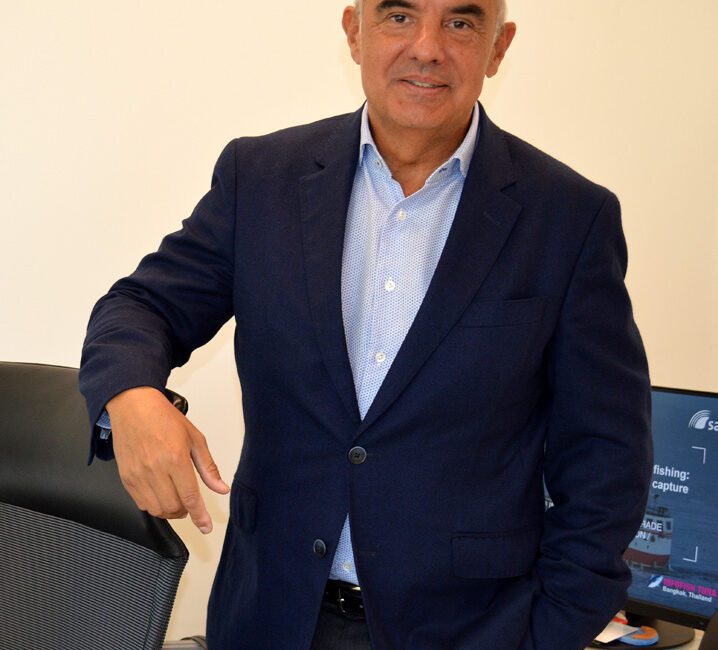Question#1 What was your company’s distinctive strategy for incorporating technology to meet UN Sustainable Development Goal?
Satlink’s main goal is to achieve and guarantee sustainability in fishing activities while enabling the industry to boost its efficiency. Thus, the SDGs are the backbone of each development and each idea (from its inception to design and final usage), focusing our solution development on the conservation of fishing resources, the fight against illegal fishing, improving the safety and living conditions of crew members, etc., all without jeopardizing global food security.
For example, our selective DSF (Device for Sustainable Fishing) is a revolutionary cutting-edge technology tool, conceived to ensure the sustainability of tuna fishing and prevent the overfishing of vulnerable species.
It allows crews to know the presence and proportion of the three main tropical tuna species and thus avoid species considered overfished or vulnerable and focus their efforts on healthy stocks.
Question#2 What challenges did you face while working on your project/ initiative, and how did you overcome them?
We had a phased approach, and a slow uptake because we wanted to be sure it really worked before fully launching it to market. The ocean environment can be tricky, and the task of distinguishing species is not easy. It requires complex technology and extensive knowledge & data on fish behavior and habits.
To be able to solve it, it was clear to us that we needed the final users (fleets) to be involved since its inception, so there were a lot of interviews, workshops, and fishing trips with them.
We have collected millions of data packages over the years to be able to fine-tune our AI-based algorithms.
Question#3 How did you involve local communities and stakeholders in your work, and what was their response?
We worked hand in hand with our customers, from top level to those at sea (final users), during the selective DSF inception, to fully understand their needs, and then design and implement it, as well as involve them during the trial phase to test it. Feedback from fleets has been crucial along the complete process, not only regarding the hardware solution, but also to make sure the information on our software is gathered and displayed in the most intuitive and easy-to-use way for crews.
Question#4 Which organizational skills and assets can be harnessed to provide its goods/services without negative environmental and social impacts?
Collaboration is key, and that’s why we work with different stakeholders, including industry, regulators, and NGOs, to streamline solutions that can address the concerns of all involved.
With our selective DSF, the fishing industry is able to fish in a more efficient and sustainable way, avoiding the most vulnerable tuna species and respecting quotas in a simple way while optimizing their fishing strategy and reducing their carbon footprint and fuel consumption through more efficient navigation. NGOs and regulators concerned with vulnerable species caught were also involved, as this new cutting-edge technology tool answers all these concerns.
Question#5 What is the role of businesses, governments, and civil society in achieving the SDGs, and how can they work together?
If we want to achieve the SDGs, collaboration is crucial, as it is not possible for one single organization to be able to answer and solve everything. Everyone, from businesses and civil society to regulators and NGOs, needs to be involved. For that, dialog and collaboration are essential to understand each stakeholder’s needs and find the best way to proceed, building on and relying on the strengths and abilities of each group, and finding common ground to work on improving towards achieving the SDGs.
Our selective DSF is a great example of how to keep improving towards achieving SGD 14 while helping all stakeholders be more efficient.
Question#6 What impact has your project had, and what are your future goals?
Our selective DSF completely changes the status quo in the tuna chain since, until now, it was not possible to exclude species while fishing, and such a level of selectivity was considered unachievable. In addition, having this information allows fishing fleets to save time and fuel on their fishing trips, which not only improves fleet efficiency, but also drastically reduces their carbon footprint.
Our future goals are to be able to achieve a higher level of detail on fish size information and increase the use of these technological tools for scientific purposes, such as having a better understanding of fishing distribution patterns, habitat preferences and behavior, among others.
Question#7 What advice do you have for individuals/organizations seeking to create positive change and contribute to the SDGs?
To think outside the box, rely on your customer’s opinions and experiences, involve all stakeholders, and try to understand the strengths, requirements and needs of all to identify common ground, and build from there.
Question#8 How would receiving this SDG Award help you improve your impact and scale your project?
We are very grateful for this recognition, as it helps us raise knowledge, understanding and usage of these technologies designed to protect ocean resources and guarantee long-term sustainability in fishing activities.
We really hope it will help us boost the use of selective DSFs in all oceans, foster links with additional organizations and get the word out that collaboration across sectors is not only possible, but key to keep improving. We also hope it will help spur new collaborative initiatives.
